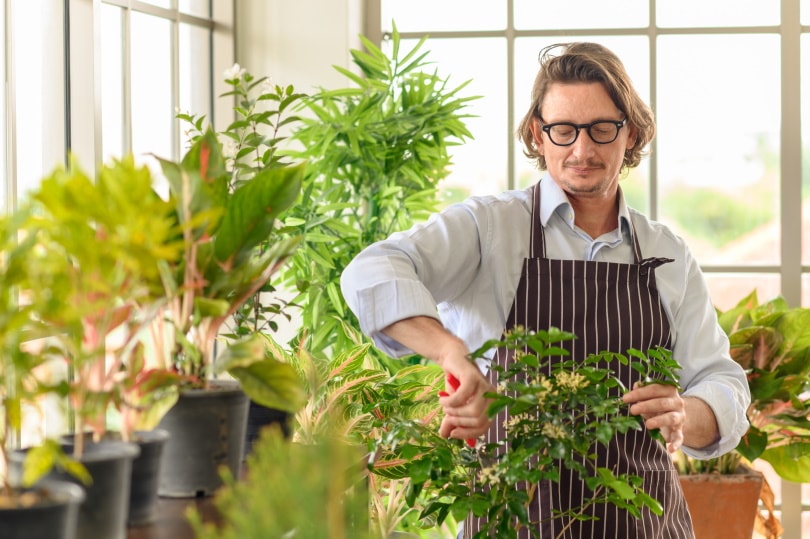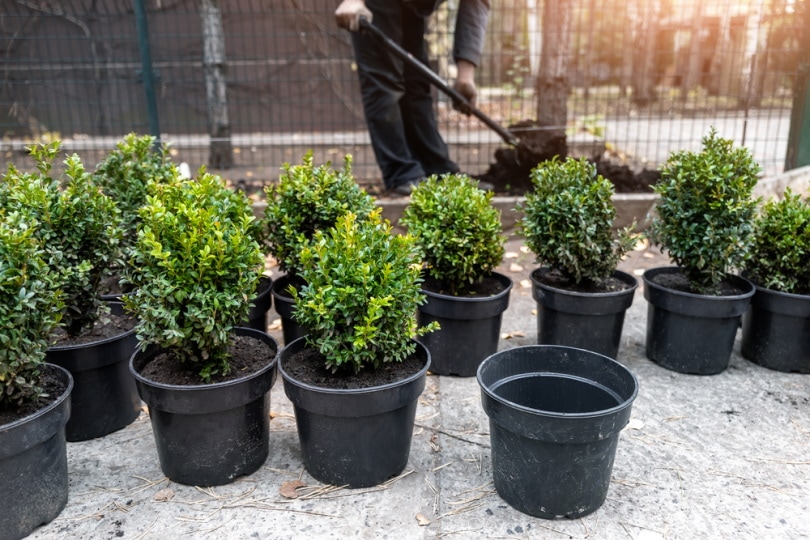How to Move Houseplants Indoors for the Winter: Step-By-Step Guide
-
Pete Ortiz
- Last updated:

It’s that time of year when the temperatures are low, the air is dry, and the days are shorter. Most of the houseplants people purchase are tropical plants, which don’t do well outside during winter, so it’s best to move your plants indoors.
However, moving houseplants indoors isn’t as easy as it may sound (but not that hard either.) Tropical houseplants have to be gradually acclimated from the outdoors to indoors to avoid sending them into shock. To keep your plants healthy, here’s an extensive step-by-step guide on how to move houseplants indoors for the winter.
The Step-By-Step Guide on How to Move Houseplants Indoors for the Winter
1. Prepare Your Houseplants
Before transitioning your plants from outdoors to indoors, you want to ensure they are in the right conditions, enabling them to thrive inside. So, you need to ensure they are clean and pest-free.
How to Debug Outdoor Plants Before Bringing Them Inside
Getting rid of pests or bugs on your outdoor houseplants before taking them indoors is important for several reasons. For starters, pest infestation is worse when the plants are inside the house compared to when they are outside since there are no pest predators indoors to control them.
Outdoor houseplants are also more prone to pest infestation during winter due to several reasons. For starters, they usually become dormant during winter, making them more susceptible to pests.
What’s more, humidity levels indoors are usually low due to the heat sources like fireplaces and space heaters. This creates the ideal breeding environment for pests, making your plants more prone to pest infestation. Here’s how to debug your plants.
Submerge Your Houseplants In Warm Water
Submerging the pot in warm water is an excellent way to force out pests inside your houseplant’s soil. Fill a bigger container with warm water, submerge the pot up to about an inch below the rim, and let it sit for approximately 15 minutes. You’ll begin to notice pests coming out of the soil. Once the 15 minutes are over, take out the pot and allow it to drain.
Manually Eliminate the Pests
Another way to eradicate pests on your houseplants is by doing it manually. Carefully inspect your plants for any pests and remove them manually by wiping them off with a damp cloth or spraying them using water.
You can also spray your houseplants with diluted commercial insecticidal soap to eliminate stubborn pests such as aphids and spider mites.
Use Neem Oil
Neem oil is a harmless yet highly effective pest eradicator. It suffocates pests such as aphids, mealybugs, and spider mites and disrupts how they feed. However, neem oil alone isn’t as effective as it has no effect once it dries. So, it is advisable to use pesticides with neem oil.
Now that we’ve looked at eliminating pests on your outdoor house plants before bringing them indoors, let’s look at the next preparation step: cleaning them.
How to Clean Outdoor Houseplants Before Moving Them Indoors
Apart from pests, outdoor plant leaves also attract dust, dirt, and other debris outside. So, it is recommended to clean them before bringing them inside. Luckily, cleaning your houseplant’s leaves isn’t hard.
You can gently clean them using a damp cheesecloth or paper towel. Alternatively, you can dilute liquid dishwashing soap, spray the mixture on the leaves, and wipe it off. Insecticidal soap is also an excellent alternative as it helps clean the leaves and eliminate pests simultaneously.
2. Acclimate Your Plants From Outdoors to Indoors

As we mentioned earlier, houseplants cannot be moved from outside to inside the house at once. Doing so will cause them to get into transfer shock, causing their leaves to wilt.
Typically, tropical plants thrive in temperatures between 65°–75°F during the day and about 50°–45°F at night. Since the temperatures are usually way below this range during winter, it’s advisable to begin bringing your plants inside at night during the fall season when the temperatures are about 50°F.
However, don’t move them inside at once. Instead, bring them indoors at night when the temperatures are approximately 50°F, then move them back outdoors during the day.
Continue with the same routine for about two weeks, but increase the time they stay indoors. By winter, your plants will have adapted to the environment inside, making it suitable to keep them indoors full-time.
3. Maintain Your Plants While They Are Indoors
While houseplants may experience a slow growth rate or become completely dormant during winter, taking care of them is still vital. Let’s take a look at different ways to maintain your houseplants while they are indoors.
Adjusting Your Watering Routine
Since houseplants experience a decrease in growth rate during winter, they may not need as much water as they did during the other seasons. So, adjusting your watering routine is vital to avoid overwatering them, leading to other issues, such as root rot.
It’s best to check if your houseplants need water before bringing out the watering can. An excellent way to do it is to stick your finger about 1–2 inches inside the soil. If it is dry, it’s time to water the plant.
It’s also important not to use cold water to water your houseplants as it can shock their roots. Usually, tap water can be pretty cold during winter. So, it’s best to let the water sit until it’s room temperature before watering your plants.
Adjust the Humidity Levels
Tropical houseplants thrive in high humidity levels. Unfortunately, the humidity inside your home decreases during winter because of the heat sources you turn on to keep you warm. So, adjusting the humidity levels is advisable for them to thrive.
An excellent way to do so is to place your houseplants near your humidifier. Alternatively, you can also move them closer together. Typically, plants naturally emit water through transpiration. So, placing them closer together will increase the humidity levels around them.
You can also place your houseplants near the bathroom or the kitchen, allowing them to absorb the moisture in those areas.
Alter the Light Levels
One of the downsides of winter is that sunlight is only available for a few hours. However, your houseplants still need adequate light to thrive, so you need to improvise.
For starters, you can move them to the window where they can easily absorb sunlight. However, be careful not to place them too close to frosty windows.
Alternatively, you can use grow light to create the perfect lighting conditions for your houseplants. However, remember that grow lights are less intense than sunlight, so you’ll need to expose your plants to the grow lights for extended periods.
Adjust the Amount of Fertilizer You Provide Your Plants
Since houseplants are practically dormant during winter, you should cut back on the fertilizer you provide them. Regularly fertilizing outdoor houseplants during this period can negatively affect their natural cycle. However, some plants, such as climbers, still actively grow during winter, so they need fertilizer in small amounts.
Final Thoughts
As you’ve noticed throughout this guide, transitioning your houseplants outdoors to indoors isn’t complicated. You need to prepare them, gradually introduce them to the environment inside your home, and maintain them while they are inside.
Just like you moved your tropical houseplants indoors, you need to gradually move them back outdoors in spring. Transferring them back outside at once can also cause issues, such as sunburn.
Featured Image Credit: Pratchaya.Lee, Shutterstock
Contents


